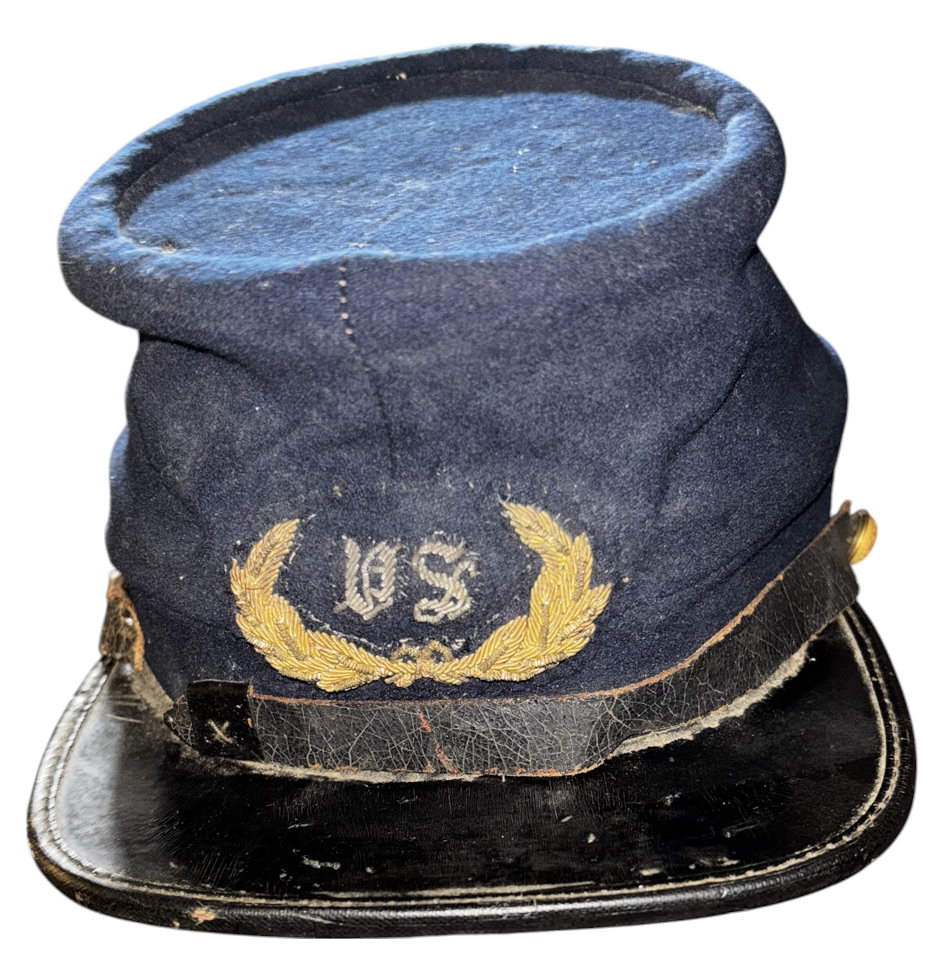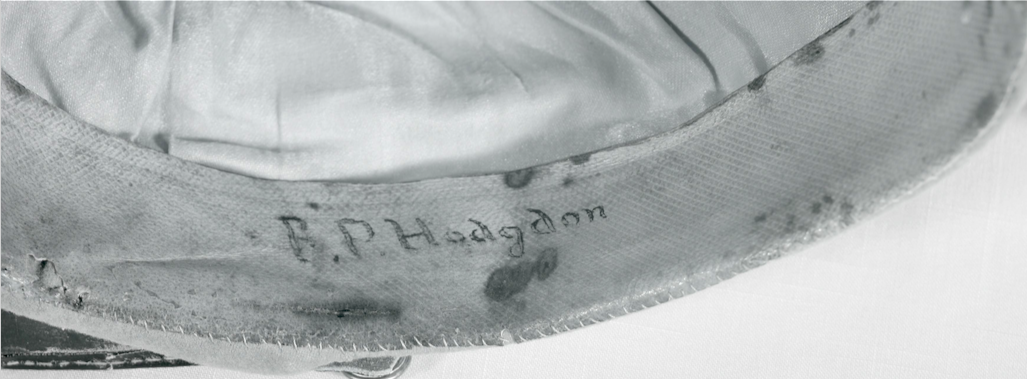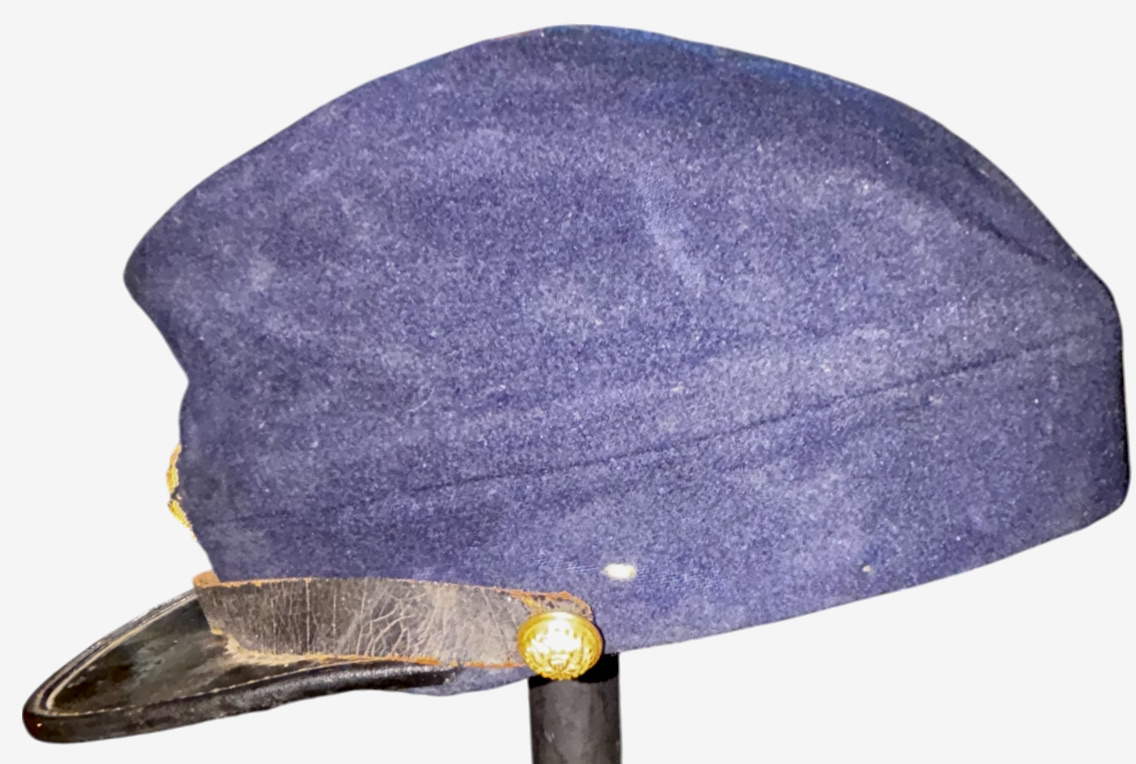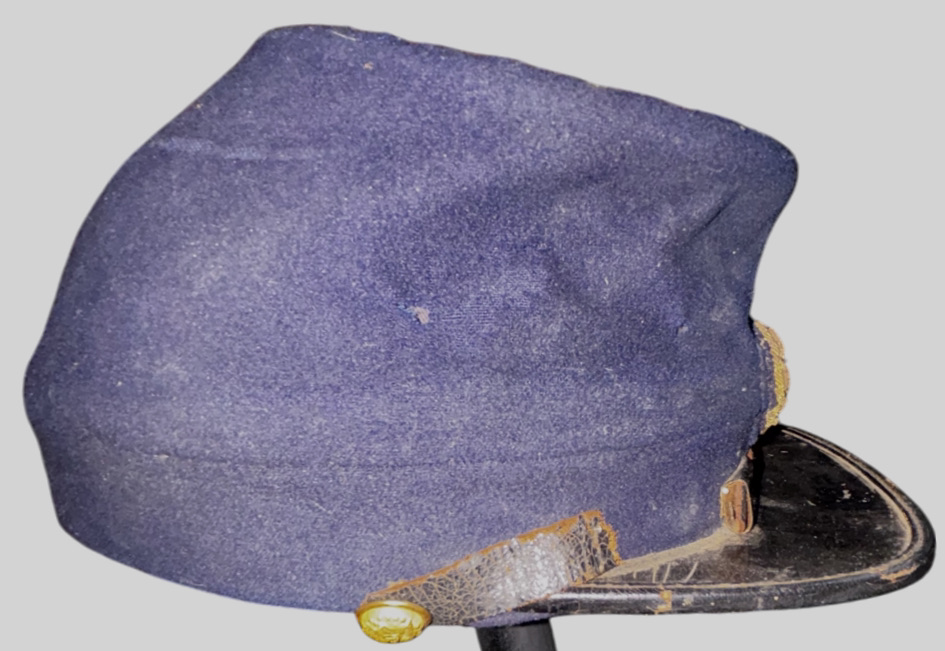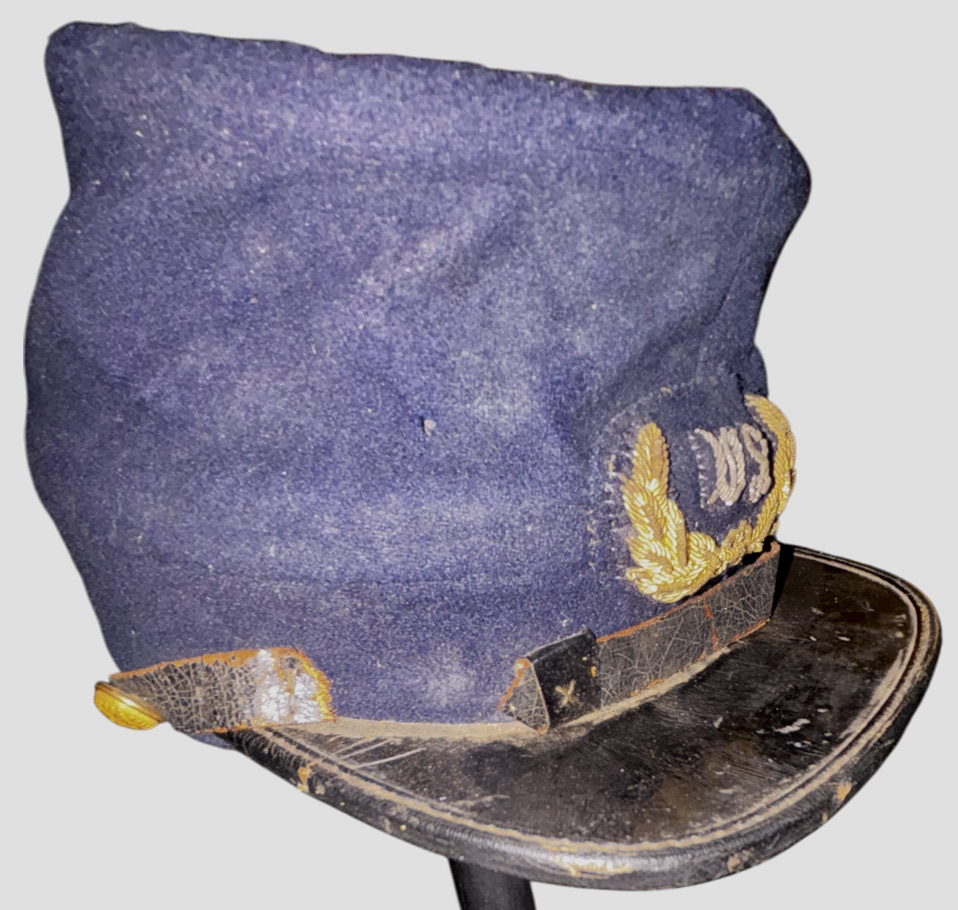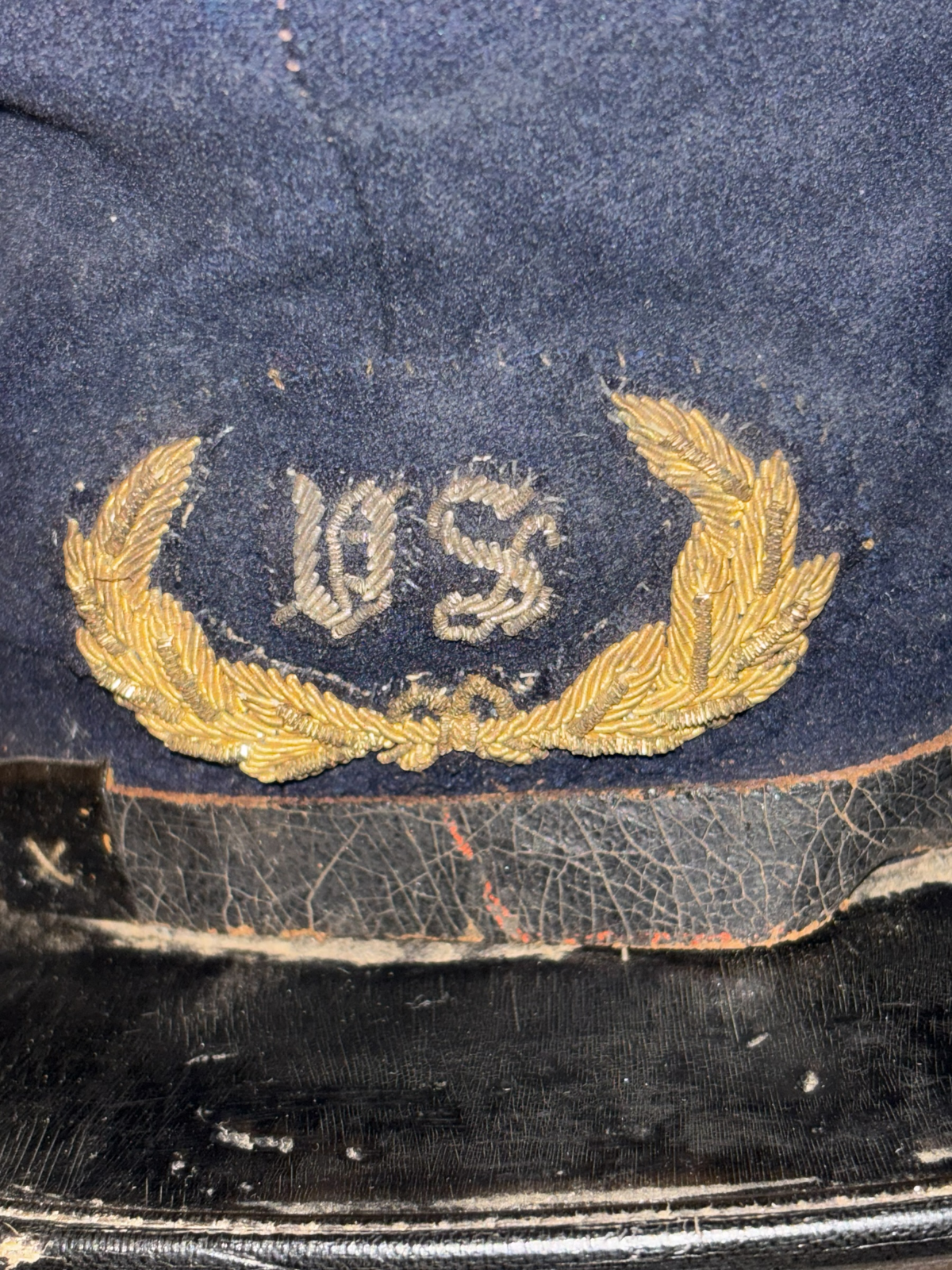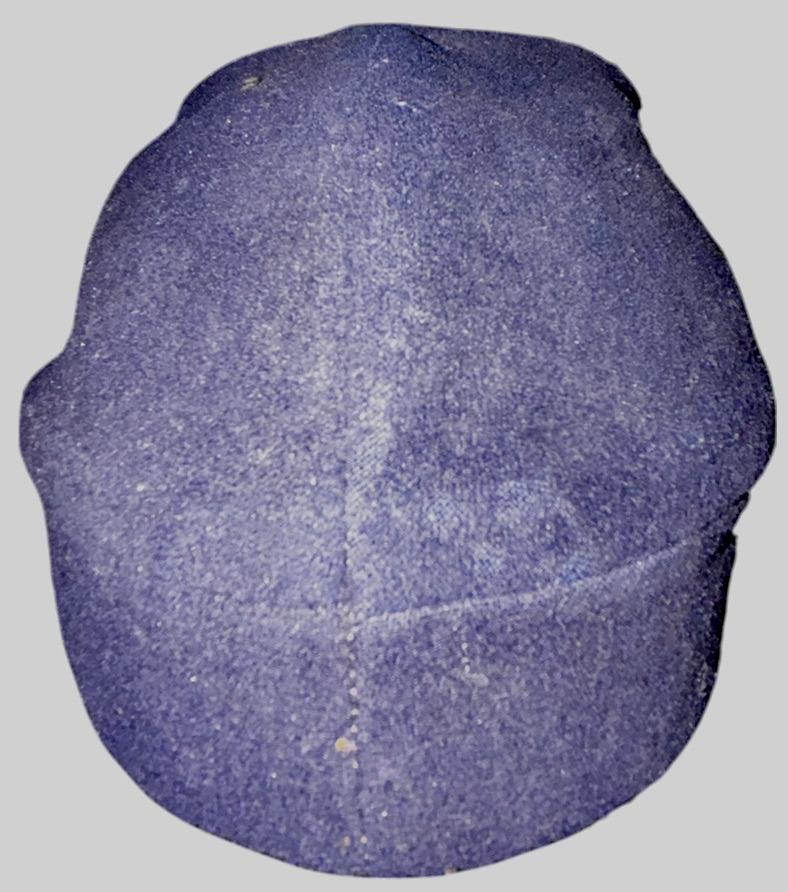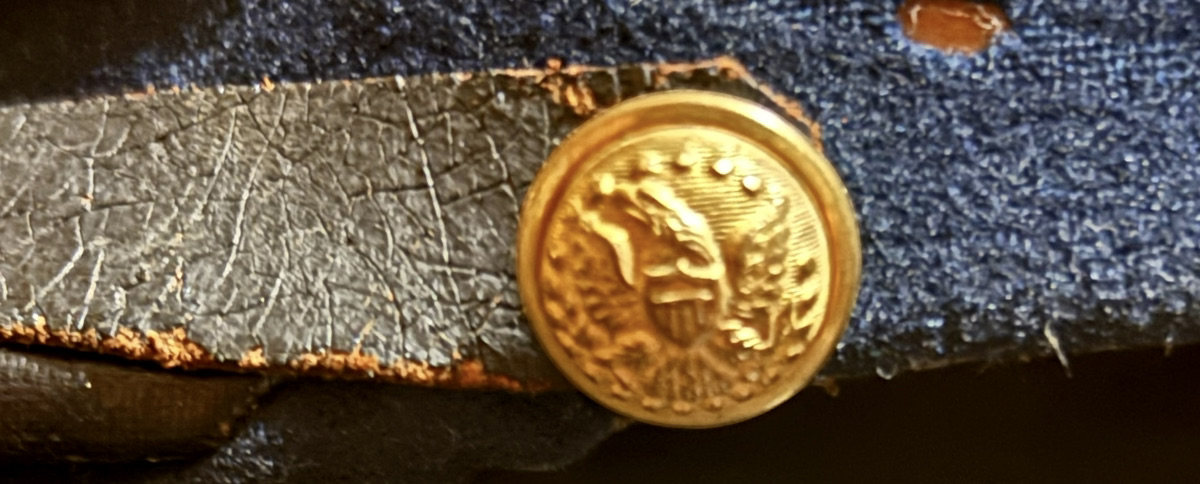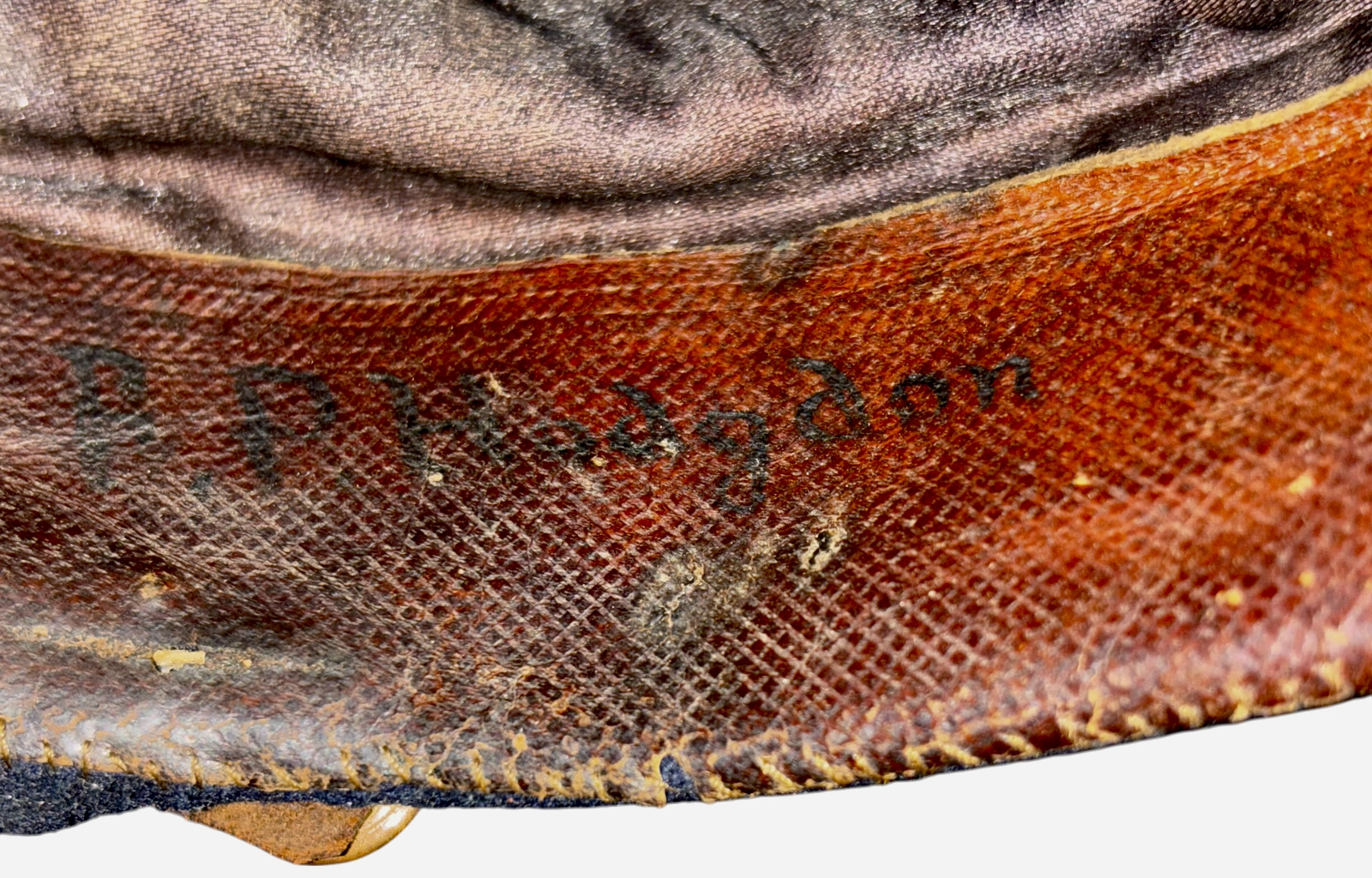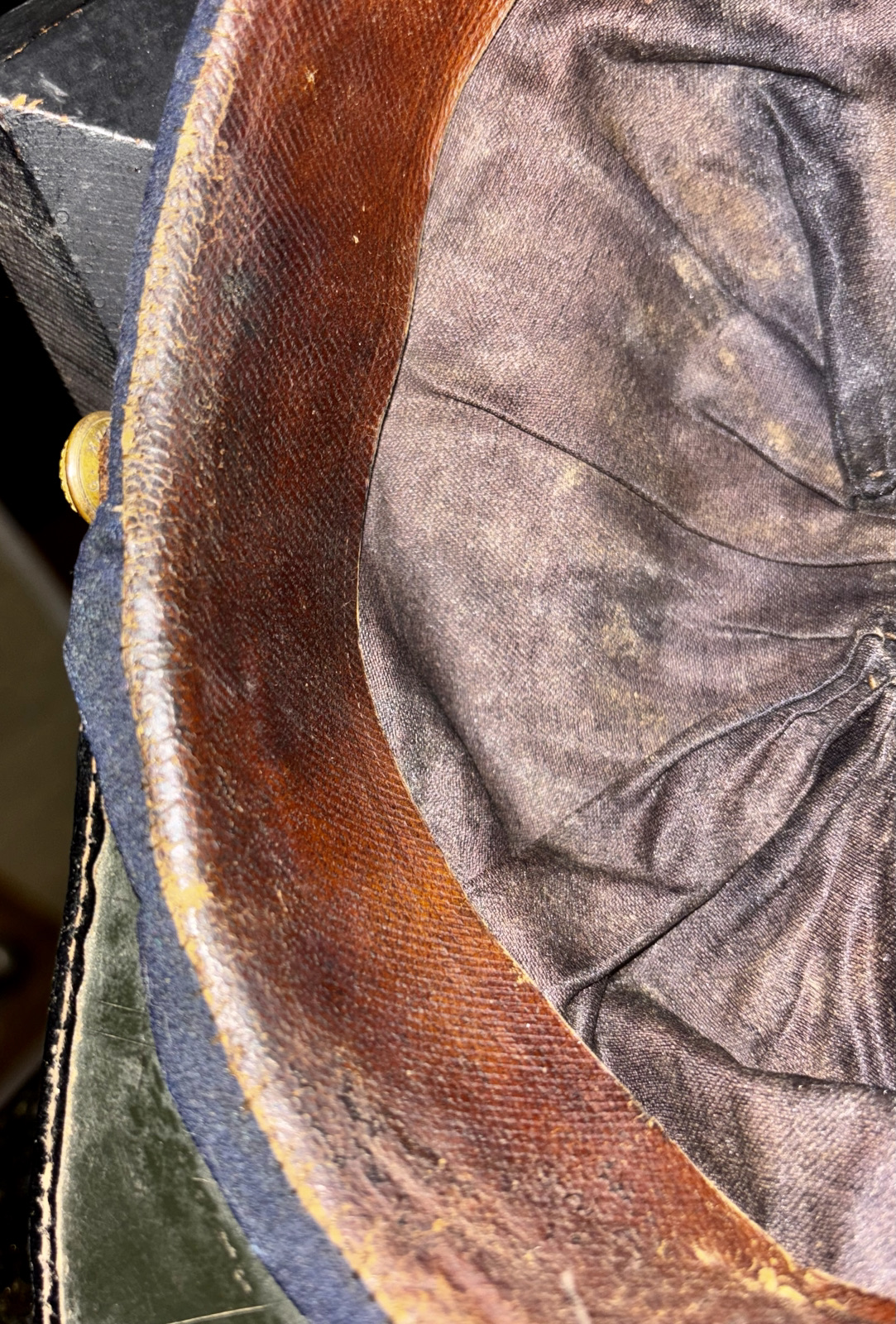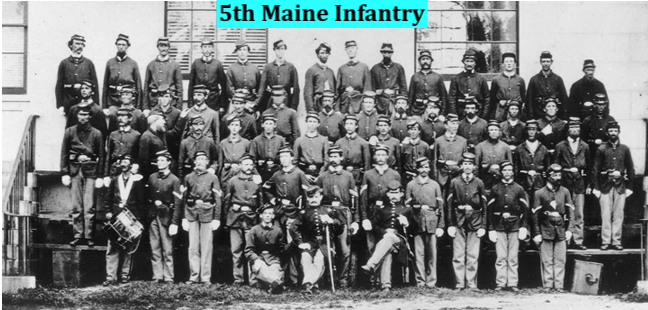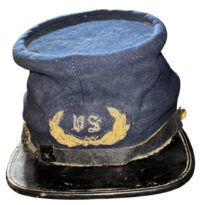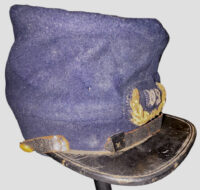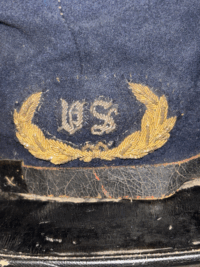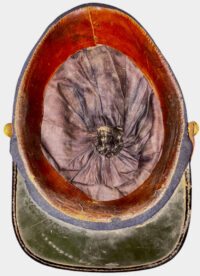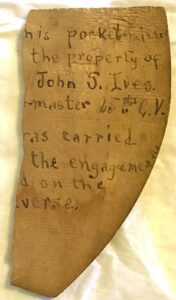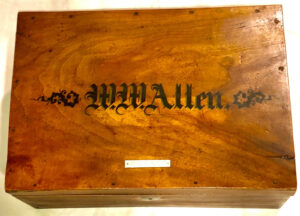Id’d Chasseur Style Civil War NCO’s Kepi Cap – Sgt. Billings Hodgdon Co. B 5th Maine Infantry
SOLD
Id’d Chasseur Style Civil War NCO’s Kepi Cap – Sgt. Billings Hodgdon Co. B 5th Maine Infantry – This cap is an excellent example of a mid-war, Union infantryman’s chasseur style kepi; the cap has a scored, brown leather sweat band, which is complete, with the name “B. P. (or F.) Hodgdon” clearly inked on the exterior of the sweatband. Hodgdon enlisted in Co. B 5th Maine Infantry in June 1861, re-enlisting in January 1864; he transferred to the 1st Maine Infantry in July 1864. Hodgdon was promoted to the rank of Corporal in 1862, then to that of Sergeant in 1863 – we presume that this is the cap he wore once promoted to the rank of Sergeant. During his service with the 5th Maine, Hodgdon would see action at the following engagements: First Bull Run, West Point, Gaines’ Mill, Charles City Cross-Roads, Crampton’s Gap, Antietam, Fredericksburg, Salem Heights, Gettysburg, Rappahannock Station, Wilderness, Spottsylvania Court House and Cold Harbor. Once he transferred to the 1st Maine Veteran Infantry, Hodgdon would see additional action at the following: Battle of Opequan, Fisher’s Hill, Cedar Creek, Siege of Petersburg, Sailor’s Creek and the Appomattox Campaign.
The cap remains in overall very good condition, with no visible insect nips and retains strong color; the cap has most of its original chin strap, with a small 1-1.5” section missing, although both, original staff officer, cuff buttons remain in place; the brim is bound with a black lacquered and has a dark, green coloring on the underside. Sewn to the front of the cap is a bullion, embroidered staff US and wreath insignia, completely original to the cap. The interior remains in excellent condition, lined with a dark brown, polished cotton, with a drawstring encircling the crown; the crown is black colored, pasteboard. The cap’s sweatband, as mentioned, is brown, scored leather, handsewn in place and complete and in excellent condition.
Billings Hodgdon
Residence Biddeford, ME; 24 years old.
Enlisted on 6/24/1861 as a Priv.
On 6/24/1861, he mustered into “B” Co. Maine 5th Infantry.
He re-enlisted on 1/4/1864.
He transferred out on 7/27/1864
On 7/27/1864, he transferred into Maine 1st Infantry.
(Date and method of discharge not given.)
Promotions:
- Corpl (1862)
- Sergt (1863)
Organized: on 6/24/1861
Mustered out: 7/27/1864
MAINE FIFTH INFANTRY (Three Years) Fifth Infantry.–Cols., Mark H. Dunnell, Nathaniel J. Jackson, Edward A. Scammon, Clark S. Edwards; Lieut.-Cols., Edwin Illsley, William S. Heath, Edward A. Scammon, Clark S. Edwards, Capt. Millett of Co. A; Majs., Samuel C. Hamilton, Edward A. Scammon, Clark S. Edwards, Capt. Millett, A. S. Daggett. This regiment was recruited from the third militia division of the state. It was mustered into the service of the United States on June 24, 1861, and numbered 1,046 men. It was made up entirely of new companies and was raised at a time when a spirit of intense patriotism prevailed throughout the state, so that little exertion was required to fill its ranks. It left Maine for Washington on June 26, fully equipped and armed with Springfield muskets and bayonets. On its way through New York City, it was the recipient of a beautiful flag, presented by the loyal sons of Maine there resident. It remained in camp at Meridian Hill, Washington, until July 5, when it commenced its march to the battlefield of Bull Run. During its three years of severe service, it was engaged in eleven pitched battles and eight skirmishes, prior to its participation in the terrible campaign of the Wilderness under Grant. Its list of battles includes First Bull Run, West Point, Gaines’ Mill, Charles City Cross-Roads, Crampton’s Gap, Antietam, Fredericksburg, Salem Heights, Gettysburg, Rappahannock Station, Wilderness, Spotsylvania Court House and Cold Harbor. In the battle of Gaines’ Mill the 5th lost 10 killed, 69 wounded and 16 missing, its gallant Col. Jackson was carried wounded from the field and Lieut.-Col. Heath was among the killed. At Rappahannock Station, the regiment was conspicuous for its gallantry, and captured 4 standards of the enemy. The flags were presented to Gen. Meade, who said: “In the name of the army and the country I thank you for the services you have rendered, particularly for the example you have set and which I doubt not on future occasions will be followed and emulated.” In a gallant charge on the enemy’s works at Spotsylvania Court House, more than half of the regiment was lost in crossing an open field subject to a raking fire of canister, but it captured the works, and took 2 flags and a large number of prisoners. In addition to the 6 captured flags, the 5th had the record of taking more men prisoners than it carried on its own rolls. It left the front near Petersburg, June 22, 1864, and started for home, arriving in Portland on the 28th with 216 men, who were mustered out of service, July 27, 1864, the veterans and recruits having been transferred to the 7th Me. During its term of service it had received some 500 recruits.
5th Maine Regiment
5th Regiment, Maine Infantry
Overview:
Organized at Portland and mustered in June 24, 1861. Left State for Washington, D. C., June 26. Attached to Howard’s Brigade, Heintzelman’s Division, McDowell’s Army of Northeastern Virginia, to August, 1861. Heintzelman’s Brigade, Division of the Potomac, to October, 1862. Slocum’s Brigade, Franklin’s Division, Army of the Potomac, to March, 1862. 2nd Brigade, 1st Division, 1st Army Corps, Army Potomac and Dept. of the Rappahannock, to May, 1862. 2nd Brigade, 1st Division, 6th Army Corps, Army Potomac, to June, 1864.
Service:
Camp at Meridian Hill till July 16, 1861. Advance on Manassas, Va., July 16-21. Battle of Bull Run July 21. Duty in the Defences of Washington till March, 1862. Expedition to Pohick Church, Va., October 3, 1861. Advance on Manassas, Va., March 10-15, 1862. McDowell’s advance on Fredericksburg, Va., April 4-12. Ordered to the Peninsula April 22. Siege of Yorktown (on Transports) April 24-May 4. West Point May 7-8. Seven days before Richmond June 25-July 1. Gaines’ Mill June 27. Golding’s Farm June 28. Savage Station June 29. Charles City Cross Roads and Glendale June 30. Malvern Hill July 1. At Harrison Landing till August 15. Retreat from the Peninsula and movement to Centreville August 15-27. In works at Centreville August 27-31. Assist in checking Pope’s rout at Bull Run and cover retreat to Fairfax C. H., September 1. Maryland Campaign September-October. Crampton’s Pass, South Mountain, September 14. Battle of Antietam September 16-17. At Hagerstown, Md., September 26 to October 29. Movement to Falmouth, Va., October 29-November 19. Battle of Fredericksburg December 12-15. “Mud March” January 20-24, 1863. Chancellorsville Campaign April 27-May 6. Operations at Franklin’s Crossing April 29-May 2. Maryes Heights, Fredericksburg, May 3. Salem Heights May 3-4. Banks’ Ford May 4. Operations about Deep Run Ravine June 6-13. Battle of Gettysburg, Pa., July 2-4. Near Funkstown, Md., July 10-13. Hagerstown July 13. Bristoe Campaign October 9-22. Advance to line of the Rappahannock November 7-8. Rappahannock Station November 7. Mine Run Campaign November 26-December 2. Campaign from the Rapidan to the James River May 3 to June 15. Battles of the Wilderness May 5-7; Laurel Hill May 8; Spottsylvania May 842; Spottsylvania C. H. May 12-21. “Bloody Angle,” assault on the Salient, May 12. North Anna River May 23-26. On line of the Pamunkey May 26-28. Totopotomoy May 28-31. Cold Harbor June 1-12. Before Petersburg June 19-22. Ordered to the rear for muster out. Mustered out July 27, 1864, expiration of term. Veterans and Recruits transferred to 6th Maine Infantry.
Regiment lost during service 8 Officers and 99 Enlisted men killed and mortally wounded and 1 Officer and 76 Enlisted men by disease. Total 184.
Federal Regiment
5th Maine Infantry
Commanding Officer on the Antietam Campaign:
Col. Nathaniel J. Jackson
This Regiment’s Chain of Command:
Army – Army of the Potomac
Corps – Sixth Army Corps
Division – 1st Division, 6th Corps
Brigade – 2nd Brigade, 1st Division, 6th Corps
Unit history
“The 5th Maine left Portland for Washington D.C. on June 25, passing through New York City where the regiment was presented with its regimental flag. The regiment was initially brigaded with the 3rd and 4th Maine and the 2nd Vermont under the command of Colonel Oliver O. Howard as part of the Third Brigade, Third Division of the Army of Northeastern Virginia. On July 21, the regiment was ordered on the “double quick” to Manassas, Virginia, a disastrous march for the men of the 5th Maine, many of whom collapsed from exhaustion, sun stroke, and dehydration while on the march. The remaining members of the 5th Maine arrived at Manassas to find a confusion of retreating Union soldiers, citizens, and others. Colonel Mark H. Dunnell noted in his report to Colonel Howard that the “best, stoutest, and bravest men failed, and fell by the roadside” among them Captain Edwards. The 5th Maine lost over four hundred men, killed, wounded, or missing.”
“In August 1861, the 5th Maine was attached to Heintzelman’s brigade. On September 9, Colonel Nathaniel J. Jackson was given command of the regiment, which led to a near mutiny in the regiment. Several officers resigned and General Henry W. Slocum had to act swiftly to prevent further mutinous acts by the members of the 5th Maine.”
(from Edwards)
Jackson’s g-g-grandson F. Suarino, from research in Whitman1, “provides some context surrounding Jacksons appointment, if not an actual explanation as to the men’s initial mutinous acts”:
The Fifth was in poor shape prior to Col. Jackson’s takeover. The unit “suffered from sickness, want of tents, cooking utensils and change of clothing. Col. Dunnell, who at the time of his election was US Consul at Vera Cruz and obtained temporary leave of absence to enable him to take command of the regiment, resigned on the 21st of August and forthwith repaired to his post in Mexico. The vacancy occasioned by his resignation was filled by the appointment of Col. Nathaniel J. Jackson, late of the First Maine, whose term of service had expired”1.
On Dec 7, 1861 Brig. General H.W. Slocum replied to an inquiry (apparently regarding the problems with the Fifth Maine) which was made by then Governor of Maine, I. Washburn, Jr.:
I have the honor of acknowledging the receipt of your letter of November twenty-ninth and in reply would say that I shall not ask the government to give me a better regiment than the Fifth Maine, in case it can be filled to the maximum standard. I do not think there is a regiment in the entire army which has improved so rapidly as Col. Jacksons has. The change has been wonderful. Their sick list is less than one third of what it was two months since. The men are cleanly, well drilled and ambitious. They are becoming proud of their regiment and are uniting cordially with Col. Jackson in all his efforts. I shall be greatly disappointed if this regiment does not do credit to your state. Fill it to the maximum and then pay us a visit and judge for yourself whether I am too sanguine …1
In the battle of Gaines’ Mill the 5th lost 10 killed, 69 wounded and 16 missing, its gallant Col. Jackson was carried wounded from the field and Lieut.-Col. Heath was among the killed.
“… Edwards was promoted to lieutenant colonel prior to the battle of Fredericksburg, Maryland (December 13, 1862), and promoted to full colonel in January 1863 after Colonel Edward A. Scammon (who had succeeded Jackson as commander of the 5th Maine) resigned.”
The monument to the 5th Maine Infantry Regiment is south of Gettysburg on the west side of Sedgwick Avenue just north of Wheatfield Road. (Sedgwick Avenue tour map) The state of Maine erected the monument in 1889.
Colonel Clark S. Edwards commanded the 5th Maine at the Battle of Gettysburg. It brought 340 men to the field and suffered no casualties.
The regiment arrived at the battlefield late on July 2. It formed behind the 5th Corps, some of which was giving ground, then advanced to the front and held the position through the night. Late on July 3 the regiment supported the 1st Brigade, 3rd Division, 5th Corps in an advance through the Wheatfield and the woods on the south. The advance captured about 200 prisoners of Benning’s Georgia Brigade and the colors of the 15th Georgia Infantry Regiment.
| Attached to the 2nd Brigade, 1st Division, 6th Corps, Army of the Potomac |
Text from the Gettysburg monument:
5th Maine Infantry
2nd Brig. 1st Div. 6th Corps
Occupied this position from evening of July 2nd until close of battle.
Mustered into the U.S. Service Portland, Me. June 24, 1861. Served with the Army of the Potomac in the field from Bull Run to Petersburg. Mustered out, Portland, June 27,1864.

